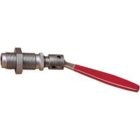All said and done, if I want .002 neck tension on my .243 bullet I need to expand back up to .240, and presumably, spring back will be around .241?
No, if you EXPAND to .240 the neck would spring back opposite this sizing to ~.239.
And no matter what you do, you WILL NEVER have .002 of neck tension. All you can get is .002 of interference, which is removed by bullet seating.
Look folks, you can set neck dimension with a bushing, and/or expander, and/or with bullets, but the outcome is the same. With a bullet seated the neck ID goes to cal, and neck OD goes to cal + neck thickness. Right? And no matter what you do or think you're doing, this is the outcome.
If you pull a seated bullet from this condition the neck will only spring back ~1thou. It will not spring back to whatever interference you had set that's greater than this ~1thou.
This is because your bullet is expanding any interference greater than ~1thou, just as an expander would. So whether you expand necks with an expander, or bullet, it's the same action and same result.
Bullets are not gripped by 'intent', but by a spring back force (a hoop tension), which we currently have no way to measure.
As mentioned earlier, you could increase the gripping force beyond this, by causing interference beyond seated bullet bearing. This would leave a binding force on bearing-base junction from the non-upsized portion of the neck. That is, the portion that the bullet was not seated deep enough to upsize.
FL sizing of necks does this, and it brings donut area into this binding.
I'll concede that in this situation, 2 or 3thou of interference leads to more gripping force than 1thou of interference. But there is no way I would ever do that or rely on that, unless shooting an underbore that actually prefers it. A cartridge that viably likes extreme starting pressures, regardless of it's variance, like 6PPC, 30br,,
maybe 6.5x47L.
A good thing about bushing dies, that nobody merchandises on,, is that you can adjust neck sizing
length as well as diameter.
If you desire truly consistent neck tension, you'll partial size necks, no longer than seated bearing. And you can reliably adjust tension here through adjustment of that sizing length.
That bullet bearing itself may vary makes no difference provided your sizing length never goes beyond seated bearing, and never beyond the sizing length YOU set. Also, seated bearing should not ever be allowed to contact donuts (which vary), or neck-shoulder junction (which expands different than necks).











